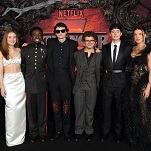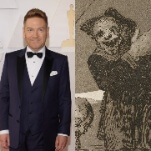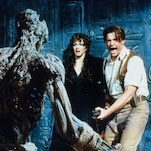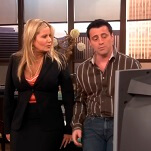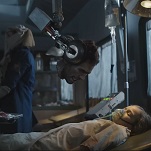Dollhouse: “Gray Hour”

Scott’s in Ohio today, depressing young people by giving a little talk about the end-times for pro critics, so I’ll be covering this fourth episode of Dollhouse, “Gray Hour,” in which our favorite body-for-hire Echo becomes a safecracker and a ringleader of a band of art thieves—and then abruptly breaks down in the middle of the job.
I’ve been watching Dollhouse from the start, and like Scott, I’m of two minds about the show. Given that it’s a Joss Whedon production, and given that Whedon’s been known to take a little while to find his footing, I’ve been willing to forgive Dollhouse’s clunky dialogue and hole-ridden premise. I’ve been clinging to the hope that Whedon will take the Dollhouse idea—which has a lot of potential—and eventually add the show to his legacy of smart television about strong women, forbidden love, and the fluidity of good and evil.
But unlike Scott, I think I’m a little more tolerant of trashy, geek-friendly TV even if it doesn’t come to much. Scott’s never been a comic book guy, and I’m not sure he’d be that interested in Dollhouse if it didn’t have the Whedon imprimatur, and some promise of a richer mythology to come. Me, I’ve been enjoying the sheer silly Charlie’s Angels-ness of Dollhouse. I can’t tell if Whedon’s dumbing down a smart idea or classing up a dumb one, but even at its dreariest—like the entire second half of last week’s episode—Dollhouse is wild, weird, and what-the-hell enough to hold my interest.
I’d place “Gray Hour” alongside “The Target” as an example of how the show’s twisty plotting and nutty backstory helps overcome some unstable foundations. If nothing else, “Gray Hour” was packed with enough mysteries and surprises to keep viewers on their toes—unlike “Stage Fright,” which ran out of plot after half an hour.
Here, it initially appears that Echo’s being sent on one of those rarely seen sexy engagements—or at least one that requires her to maximize her rack and show off her lap-dancing skills—but it turns out that her drunken high-priced whore routine is just a con, designed to get her into the chambers of hotel security, so she can knock out a guard and gain access to a secret vault. She becomes tough-talking Taffy, commanding a crew of experts who are planning to take advantage of a “gray hour” (when the alarms are down) to steal a chunk of the original Parthenon from a store of “controversial” art. (“Controversial” meaning counterfeit or stolen.)
The problem is that despite Taffy’s let’s-get-to-it-boys motivational speeches about how she doesn’t care who the client is and doesn’t want to be famous like Bonnie Parker, her crew’s Rat-Faced Art-Expert sneaks away with the goods. And to make matters worse, when Taffy calls Boyd to tell him to stop the RFAE, she hears an electronic shriek and then utters those tell-tale I-just-got-wiped words, “Did I fall asleep?”
That alone is a cool enough twist, but “Gray Hour” twists it even further when Ms. DeWitt decides to salvage the job by implanting the “Taffy” persona into Sierra. But before Sierra-Taffy can spill what she knows about getting into and out of the art-vault, she grumbles about not getting to do her lap-dance, and demands to be paid up front. (I don’t know about you, but whenever one of Ms. DeWitt’s underlings starts giving her lip, I imagine them shouting, “I saved Latin! What did you ever do?”) Because Echo-Taffy—now reduced to just Echo—is a directionless lump, Sierra-Taffy’s telephone instructions to her fail, and Wiped Echo has to fall back on a more basic programming. Either her crew or the cops are going to kill her if she doesn’t take action.
I really enjoyed the “What next?” hairpin curves of “Gray Hour,” but as with “The Target” (and every other Dollhouse episode to date), I can’t call this one an unqualified success. At several points I had to rewind because I couldn’t understand the dialogue, only to discover that I’d heard the dialogue right… it just wasn’t very good. (I’m sure this reads okay on the page, but try to say this Boyd line aloud in a way that makes immediate sense: “You drop it, I shoot you. Then you don’t get paid. Or breathe.”) Also, looking back on it, given the time constraints they were under, I’m not sure why they had to activate Sierra-Taffy. If all that knowledge about the vault is in the Dollhouse computer, why couldn’t they just pull it up themselves? (Or does this have something to do with the client confidentiality speech that Ms. DeWitt gives early in the episode? Even if it does, it’s kind of silly.)
I did think this was one of the few jobs we’ve seen so far where it really did make sense to hire a Doll. Just witnessing the every-man-for-himself actions of Taffy’s crew makes it clear that having someone who’ll “disappear” after a heist is a necessary convenience. Aside from that though, I’m still having a little bit of trouble suspending disbelief with the whole Dollhouse business model. I’m willing to accept the science of it all—hey, I watch Lost, so I’m very good and going along for the ride—but I don’t get why all the technological know-how is in the hands of jittery, unreliable Topher. Tonight, Topher hinted he has rivals in the organization. I hope they emerge soon.

